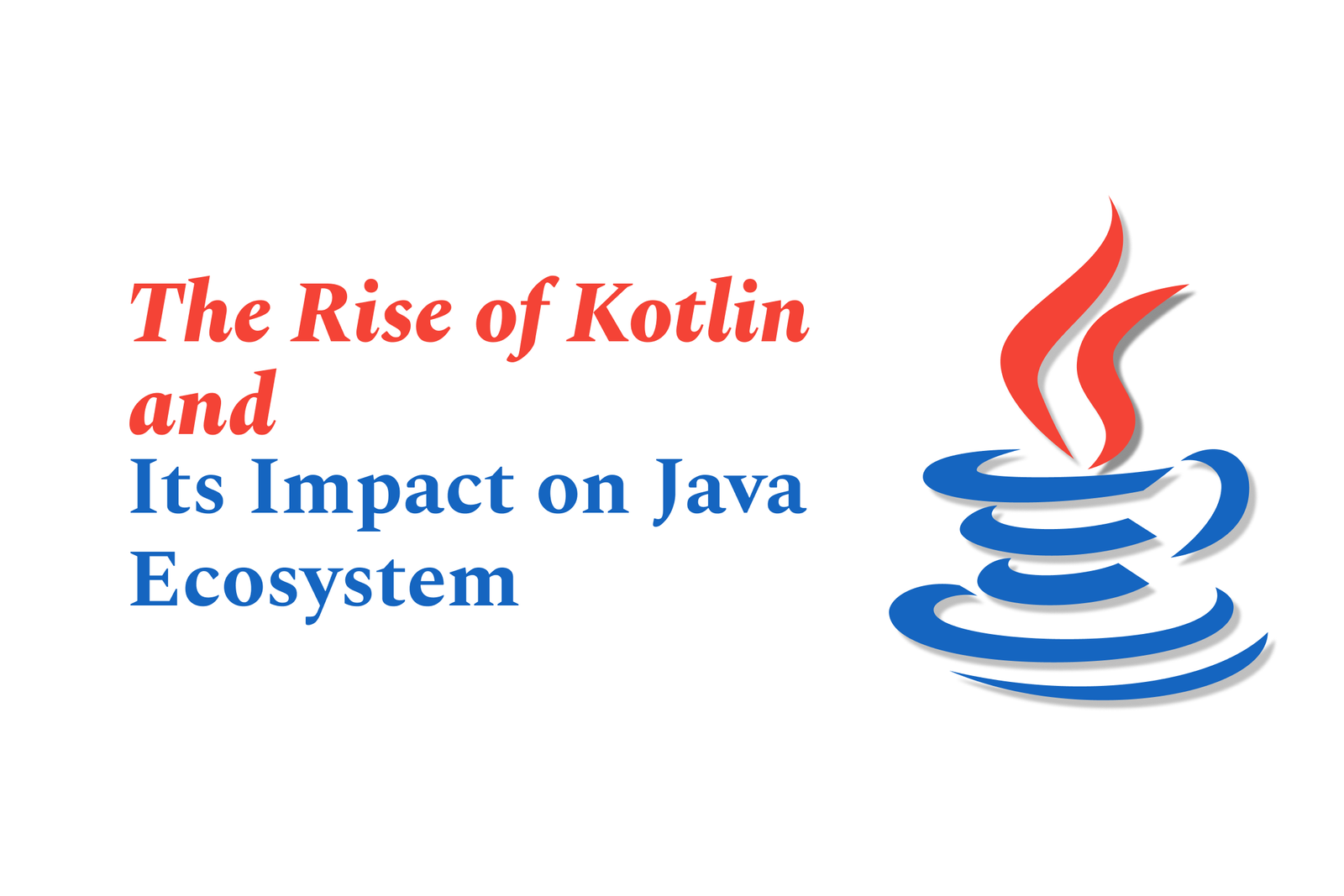The Rise of Kotlin and Its Impact on Java Ecosystem
Kotlin, a modern JVM language endorsed by Google for Android, offers concise syntax and seamless Java interoperability. Its rise drives innovation, enhances developer productivity, and fosters cross-platform development, significantly transforming and modernizing the traditional Java ecosystem.
The Rise of Kotlin and Its Impact on Java Ecosystem
1 ) Introduction to Kotlin and Its Growing Popularity
Kotlin, introduced by JetBrains in 2011, is a modern statically typed language that runs on the Java Virtual Machine (JVM).
It gained significant traction after Google endorsed it as the preferred language for Android development in 2019.
Kotlin offers modern features, enhanced readability, and seamless interoperability with Java, making it appealing for new and evolving projects.
2 ) Comparison with Java: Why Kotlin?
Despite Java’s long standing robustness and widespread use, Kotlin addresses some of its limitations by providing more concise syntax and modern programming capabilities.
Kotlin’s interoperability with Java allows gradual migration or mixed use without sacrificing existing environments.
Surveys show that although Kotlin developers are fewer (approx. 10%) compared to Java developers (approx. 90%), this presents an opportunity for early adoption and less competition for talent in a growing ecosystem.
3 ) Kotlin Multiplatform (KMP) as a Strategic Innovation
Kotlin Multiplatform enables developers to write code that runs across multiple platforms (Android, iOS, web, desktop), promoting code reuse and efficiency.
JetBrains heavily invests in KMP as a strategic product, seeing it as crucial for their future competitiveness in the integrated development environment (IDE) market.
Google also supports Kotlin Multiplatform to maintain control over the mobile ecosystem, positioning it as a counter strategy against frameworks like React Native.
4 ) Impact on the Java Ecosystem
Kotlin’s rise promotes modernization within the JVM ecosystem, encouraging smoother integration with existing Java infrastructure.
It has stimulated innovation in tooling, libraries (e.g., kotlinx.coroutines, Ktor), and frameworks, enhancing developer productivity.
The shift triggers some challenges, such as adapting JVM libraries and tools to support Kotlin features, but also revitalizes the ecosystem by attracting new talent and usage patterns.
5 ) Talent Market Dynamics
The software development job market still heavily favors Java developers but Kotlin demand is growing steadily.
Companies adopting Kotlin early benefit from a less crowded hiring field and access to motivated developers seeking to work with modern technologies.
Developers’ growing experience and adoption of Kotlin indicate a maturing community and expanding ecosystem support.
6 ) Ecosystem and Tooling Support
IntelliJ IDEA remains the favored IDE for Kotlin development, with Android Studio built on the same platform enhancing mobile development.
JetBrains supports a rich ecosystem of libraries and frameworks tailored for Kotlin, including multiplatform UI frameworks such as Compose Multiplatform.
Continuous improvements in build systems and compiler performance aim to mitigate concerns like compilation speed compared to Java.
7 ) Challenges and Future Outlook
Some early skepticism existed around Kotlin Multiplatform maturity and compilation performance, but ongoing investments have addressed many concerns.
Kotlin’s strategic importance to JetBrains and Google ensures sustained development, broad adoption, and a competitive alternative within JVM based ecosystems.
The technological synergy and community momentum forecast Kotlin’s continuing rise and evolving impact on the Java ecosystem and beyond.
Summary: Kotlin has emerged as a compelling modern language alternative to Java, facilitating innovation while maintaining JVM compatibility. Its strategic backing by JetBrains and Google, combined with an expanding developer base and rich tooling ecosystem, positions Kotlin as a transformative force that positively influences the evolving Java ecosystem by bringing modern, cross platform capabilities and attracting new talent to JVM development.
https://justacademy.in/news-detail/how-ios-19-enhances-app-store-review-process
https://justacademy.in/news-detail/google-i/o-2025-highlights:-flutter-takes-the-lead
https://justacademy.in/news-detail/react-native?s-upcoming-features:-what-to-watch-for
https://justacademy.in/news-detail/adaptive-ui-in-flutter-4.0
https://justacademy.in/news-detail/flutter-and-blockchain-integration
Related Posts
In 2025, top Angular libraries offer modern, feature-rich components and tools for building dynamic web apps. From powerful data grids to low-code platforms like UI Bakery, these libraries enhance development speed, UI design, and scalability, making them essential for Angular developers.
Migrating from AngularJS to Angular 17 involves gradually upgrading your app by running both frameworks together using tools like ngUpgrade, rewriting components in TypeScript, and adopting Angular’s modern architecture to enhance performance, maintainability, and long-term support.
Angular state management tools help organize and handle app data efficiently, improving scalability and maintainability. Popular options include NgRx for robust, RxJS-based patterns, and newer Signal Store solutions that offer simpler, reactive approaches integrated tightly with Angular’s latest features.
RxJS in Angular empowers developers to manage asynchronous data streams with powerful operators like `forkJoin`, `combineLatest`, and `zip`. Mastering these key operators in 2025 is essential for building efficient, reactive applications that handle complex event sequences seamlessly.
Angular performance optimization in 2025 focuses on improving app speed and responsiveness by using techniques like OnPush change detection, lazy loading, efficient data caching, and AOT compilation. These practices reduce load times, enhance user experience, and ensure scalable, fast Angular applications.
In 2025, Angular remains preferred for large-scale, enterprise apps with its robust, all-in-one framework, while Vue attracts developers seeking simplicity and fast development for smaller projects. Both frameworks excel, with choice driven by project needs and team expertise.
Angular Signals are a new reactive primitive in Angular 16 that enable fine-grained, efficient change detection by automatically tracking dependencies and updating only affected parts of the UI. They simplify state management and boost app performance, revolutionizing Angular's reactivity model.
Angular interview questions to prepare in 2025 focus on core concepts like components, directives, data binding, routing, and dependency injection, along with TypeScript mastery and latest Angular features to ensure strong practical knowledge for building scalable, efficient web applications.
AngularJS reached its official end of support in January 2022, meaning no further updates or security patches. To ensure app security and performance, developers should consider migrating to modern Angular versions or seek third-party long-term support options if immediate migration isn’t possible.
The Angular Roadmap 2025 highlights upcoming features focused on improving developer experience and performance, including zoneless Angular, Signals integration, enhanced Forms, async data handling, improved HMR, and expanded Angular Material/CDK enhancements, driving modern, efficient web app development.










